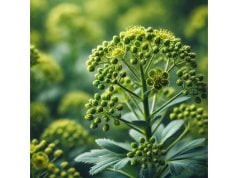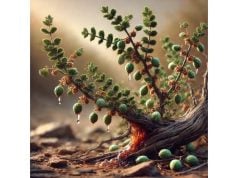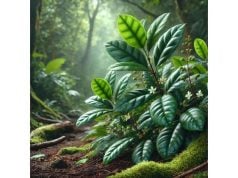
Ginger Lily is a captivating herbaceous plant celebrated not only for its breathtaking, fragrant blooms but also for its remarkable therapeutic properties. This versatile plant has been revered in traditional medicine for alleviating respiratory issues, reducing inflammation, and promoting overall wellness. Its potent bioactive constituents, found in the delicate petals and rhizomes, contribute to a myriad of health benefits ranging from soothing digestive discomfort to boosting immunity. In this comprehensive guide, we delve into Ginger Lily’s botanical characteristics, its impressive array of active compounds, its healing advantages, practical applications, and the scientific research supporting its benefits.
Table of Contents
- Floral Traits & Identification
- Active Constituents & Chemical Profile
- Healing Advantages & Health Attributes
- Practical Uses & Safety Guidelines
- Research Discoveries & Key Studies
- Frequently Asked Questions
Floral Traits & Identification
Ginger Lily, belonging to the Zingiberaceae family, is a perennial herb known for its exotic flowers and aromatic qualities. Native to the tropical and subtropical regions of Asia, this plant has become a symbol of both ornamental beauty and natural healing. Its taxonomy places it within the genus Hedychium, with several species widely cultivated for their ornamental and medicinal properties. Among the most renowned is Hedychium coronarium, commonly referred to as the white ginger lily, though variations in color and form exist across different species.
Botanical Classification
- Kingdom: Plantae
- Division: Angiosperms
- Class: Monocots
- Order: Zingiberales
- Family: Zingiberaceae
- Genus: Hedychium
- Species: Commonly H. coronarium (others include H. gardnerianum, H. flavum)
Morphological Characteristics
Ginger Lily is celebrated for its unique floral display and distinct structural features. Its key botanical attributes include:
- Rhizomes: The underground rhizomes are robust and fibrous, storing essential nutrients and bioactive compounds. These rhizomes play a crucial role in both vegetative reproduction and medicinal extractions.
- Stems and Leaves: The plant exhibits slender, erect pseudostems formed by the overlapping leaf bases. Its leaves are long, lanceolate, and glossy, arranged alternately to create an elegant, arching canopy. These leaves not only contribute to the plant’s overall aesthetic appeal but also serve as a medium for photosynthesis and nutrient absorption.
- Flowers: The star attraction of Ginger Lily is its large, showy inflorescences. The flowers, typically white or pale yellow with hints of pink or orange, are arranged in graceful clusters. Their petals are delicate yet resilient, exuding a subtle, spicy fragrance that is both soothing and invigorating. The intricate structure of the flower—with its prominent labellum and unique reproductive organs—facilitates pollination by attracting specific insect pollinators.
- Aroma and Aesthetics: The natural scent of Ginger Lily is a blend of sweet and spicy notes, often compared to that of its culinary cousin, ginger. This alluring aroma has not only made it a favorite in ornamental gardening but also in the production of essential oils and natural perfumes.
Growth Conditions and Natural Habitat
Ginger Lily thrives in warm, humid environments, preferring partial sunlight and well-drained, fertile soils. Its ideal habitat includes:
- Tropical and Subtropical Regions: The plant flourishes in regions with high humidity and consistent rainfall, typically found in Southeast Asia.
- Understory Growth: In its natural setting, Ginger Lily often grows as an understory plant in dense forests where dappled sunlight filters through the canopy.
- Cultivation Practices: Modern horticultural practices have enabled the successful cultivation of Ginger Lily in controlled environments, including greenhouses and landscaped gardens in temperate regions. Organic cultivation methods are often employed to preserve its natural bioactive compounds.
Identification in the Field
Identifying Ginger Lily in the wild or in a garden setting involves a keen eye for detail:
- Rhizome Examination: Digging carefully near the base of the plant reveals a network of knobby, fibrous rhizomes encased in a thin, papery layer. These structures are prized for their medicinal qualities.
- Leaf Arrangement: The long, glossy leaves, which emerge from the pseudostem in an alternating pattern, are a hallmark of the species. Their vibrant green hue contrasts beautifully with the pale floral tones.
- Flower Morphology: During the blooming season, the large, fragrant flowers are unmistakable. Their elegant, elongated petals and unique structure are distinct markers that help differentiate Ginger Lily from other ornamental species.
- Environmental Cues: The plant is typically found in humid, semi-shaded areas with rich, loamy soil—a clear indication of its natural habitat preferences.
Cultural and Historical Significance
Ginger Lily holds a special place in various cultural traditions:
- Traditional Medicine: In many Asian cultures, extracts from the rhizomes and flowers are used to treat respiratory ailments, digestive disorders, and inflammation.
- Symbolism: The plant is often associated with purity and elegance. In traditional festivals and ceremonies, its blooms are used for decoration and in ritualistic practices.
- Modern Applications: Today, Ginger Lily is not only admired for its beauty but is also studied for its potential health benefits, leading to its incorporation in natural remedies and cosmetic formulations.
Through centuries of cultivation and use, Ginger Lily has evolved from a wild tropical plant into a cultivated species admired globally for its ornamental charm and medicinal potential. Its botanical profile and ease of identification make it a favorite among gardeners, herbalists, and researchers alike, providing a rich subject for further study and application in natural health practices.
Active Constituents & Chemical Profile
The therapeutic prowess of Ginger Lily is largely attributed to its rich chemical composition. Extensive research has identified a spectrum of bioactive compounds that work synergistically to deliver a range of health benefits. Below is a detailed, list of the key active constituents found in Ginger Lily, along with an in-depth look at their properties and potential applications.
- Hedychylactone
Hedychylactone is a prominent sesquiterpene lactone unique to Ginger Lily. This compound exhibits potent anti-inflammatory properties, making it a valuable natural remedy for conditions such as arthritis and muscle inflammation. Research indicates that hedychylactone helps modulate the body’s inflammatory responses by inhibiting key enzymes and cytokines involved in the inflammation process. Additionally, its antioxidant activity supports cellular health by neutralizing free radicals, thereby reducing oxidative stress and promoting overall well-being. - Hedychinol
Classified as a bioactive flavonoid, hedychinol is another critical component of Ginger Lily. Flavonoids are renowned for their ability to combat oxidative damage, and hedychinol is no exception. It works by scavenging harmful free radicals, which may help prevent cellular aging and reduce the risk of chronic diseases. Moreover, hedychinol has been observed to exhibit antimicrobial properties, potentially aiding in the prevention of infections. Its role in supporting immune function makes it a subject of interest for further research in natural immunomodulators. - Linalool
Linalool is a monoterpenoid alcohol widely recognized for its pleasant, floral aroma and calming effects. In Ginger Lily, linalool contributes significantly to the plant’s distinctive fragrance and is believed to have mild sedative and anti-anxiety properties. Studies suggest that linalool can enhance mood and promote relaxation, making it a popular ingredient in aromatherapy and cosmetic formulations. Its antimicrobial and anti-inflammatory actions further bolster its therapeutic value, positioning linalool as an essential compound in the holistic applications of Ginger Lily. - 1,8-Cineole (Eucalyptol)
Also known as eucalyptol, 1,8-cineole is a monoterpene with a characteristic eucalyptus-like aroma. This compound is highly valued for its respiratory benefits; it is commonly used to alleviate symptoms of congestion, bronchitis, and sinusitis. 1,8-Cineole works by stimulating secretions in the respiratory tract, thereby easing breathing and reducing mucus accumulation. Its anti-inflammatory and analgesic properties also contribute to its use in managing minor aches and pains, making it a versatile component in natural remedies for respiratory and inflammatory conditions. - Citral
Citral is a naturally occurring mixture of two isomeric aldehydes—geranial and neral—that contribute a strong lemon-like scent to Ginger Lily. This compound is well-regarded for its antimicrobial and anti-inflammatory properties. Citral has been shown to inhibit the growth of certain bacteria and fungi, offering potential applications in both food preservation and natural skincare products. Additionally, its ability to modulate inflammatory pathways may support the management of inflammatory skin conditions and other systemic inflammatory disorders.
Synergistic Effects and Bioavailability
The complex interplay between these active constituents results in a synergistic effect that enhances the overall efficacy of Ginger Lily. While each compound offers unique benefits, their combined presence often leads to improved bioavailability and potency compared to isolated extracts. Factors such as extraction method, preparation technique, and dosage can influence the degree to which these compounds are absorbed and utilized by the body.
Extraction and Standardization Techniques
Modern extraction methods, such as steam distillation and ethanol extraction, are commonly employed to isolate these bioactive compounds from Ginger Lily. Standardization of extracts ensures that the final product contains a consistent concentration of key constituents, which is crucial for both therapeutic efficacy and consumer safety. Advances in extraction technology continue to improve the stability and bioavailability of these compounds, paving the way for innovative formulations in natural health products and cosmetics.
The rich chemical profile of Ginger Lily not only underpins its traditional use in herbal medicine but also opens up exciting possibilities for modern therapeutic applications. As research continues to uncover the intricate mechanisms by which these compounds exert their effects, Ginger Lily remains a promising candidate in the development of natural remedies that combine efficacy with a holistic approach to wellness.
Healing Advantages & Health Attributes
Ginger Lily’s extensive range of healing advantages has made it a staple in traditional medicine and an emerging subject of modern scientific inquiry. The blend of active constituents found in this herb supports numerous physiological functions, contributing to its reputation as a natural remedy for various health issues.
Anti-Inflammatory and Analgesic Effects
One of the most celebrated benefits of Ginger Lily is its ability to reduce inflammation. Compounds such as hedychylactone and 1,8-cineole actively inhibit inflammatory mediators, providing relief from conditions such as arthritis, muscle soreness, and even mild joint pain. This anti-inflammatory action not only helps manage pain but also contributes to overall mobility and quality of life for individuals suffering from chronic inflammatory conditions.
Antioxidant and Immune-Boosting Properties
The potent antioxidant activity of Ginger Lily is another cornerstone of its health benefits. Hedychinol, along with other flavonoids present in the plant, plays a critical role in neutralizing free radicals that can damage cells and accelerate aging. By reducing oxidative stress, these antioxidants support a robust immune system and help lower the risk of chronic diseases, including cardiovascular issues and certain cancers. Regular use of Ginger Lily extracts may enhance the body’s natural defense mechanisms and promote long-term wellness.
Respiratory and Digestive Support
Historically, Ginger Lily has been used to alleviate respiratory ailments. The presence of 1,8-cineole and linalool assists in clearing nasal passages and soothing irritated airways, making it a natural choice for those suffering from bronchitis, sinusitis, or seasonal allergies. In addition, the herb’s digestive benefits are notable—its bioactive compounds stimulate digestive secretions and improve gut motility, which can help alleviate symptoms of indigestion, bloating, and mild gastrointestinal discomfort.
Skin and Cosmetic Applications
Beyond internal health, Ginger Lily is increasingly recognized for its benefits in skincare. The antimicrobial and anti-inflammatory properties of citral and linalool make the herb a valuable ingredient in natural cosmetic formulations. When applied topically, Ginger Lily extracts may help reduce skin inflammation, combat acne-causing bacteria, and promote a clearer, more radiant complexion. Its antioxidant properties further protect the skin from environmental stressors and premature aging.
Neurological and Mood-Enhancing Benefits
Preliminary studies suggest that the calming effects of linalool and the overall aromatic profile of Ginger Lily can have a positive impact on mental well-being. The gentle sedative properties may help reduce stress and anxiety, leading to improved sleep quality and a more balanced mood. While further research is needed to fully understand these neurological benefits, early findings indicate that Ginger Lily could serve as a complementary approach to managing everyday stress and enhancing cognitive function.
Holistic Wellness and Preventive Health
The integrative benefits of Ginger Lily extend to overall holistic wellness. Its blend of anti-inflammatory, antioxidant, and antimicrobial properties supports the body’s natural healing processes, helping to maintain a state of balance and resilience. Regular inclusion of Ginger Lily in one’s diet or wellness regimen may contribute to improved vitality, reduced incidence of minor illnesses, and enhanced recovery from physical exertion. Its multifaceted benefits make it an excellent candidate for those seeking natural, preventive approaches to health management.
By addressing multiple aspects of health—from reducing inflammation to boosting immunity and supporting skin health—Ginger Lily represents a powerful ally in the pursuit of a balanced, healthful lifestyle. Its healing advantages, underpinned by a rich array of bioactive compounds, provide a compelling case for its inclusion in both traditional herbal remedies and modern wellness protocols.
Practical Uses & Safety Guidelines
Ginger Lily’s versatility shines through its wide range of applications, spanning culinary, medicinal, and cosmetic domains. Whether used as a flavor enhancer, a natural remedy, or an ingredient in skincare products, understanding how to utilize this herb effectively is key to unlocking its full potential. Here, we explore practical usage tips, dosage recommendations, and important safety considerations to ensure a balanced approach to incorporating Ginger Lily into your routine.
Culinary Applications
In the culinary world, Ginger Lily is appreciated for its aromatic qualities and unique flavor profile. While it may not be as commonly used as traditional ginger in cooking, innovative chefs and home cooks are increasingly exploring its potential:
- Infusions and Teas: Fresh or dried Ginger Lily petals and rhizomes can be steeped in hot water to produce a fragrant herbal tea. This infusion not only offers a gentle, spicy-sweet flavor but also imparts subtle health benefits.
- Flavor Enhancer: The extracts of Ginger Lily can be added to sauces, marinades, or dressings, contributing a distinctive aroma and mild, peppery taste to various dishes.
- Baking and Confectionery: In some cultures, ground Ginger Lily is incorporated into baked goods and confections, lending a unique twist to traditional recipes.
Medicinal Preparations
Traditional medicine has long recognized the therapeutic potential of Ginger Lily. Its extracts are prepared in various forms to address a range of health concerns:
- Decoctions and Tinctures: Boiling the rhizomes and petals in water or alcohol extracts the bioactive compounds, creating potent decoctions or tinctures that can be used to alleviate respiratory issues and digestive discomfort.
- Capsules and Supplements: Standardized extracts of Ginger Lily are available as dietary supplements, offering a convenient way to harness its medicinal properties without the need for elaborate preparation.
- Topical Applications: Ginger Lily-infused oils, creams, and balms are used in aromatherapy and massage therapy. When applied to the skin, these formulations can help reduce inflammation, soothe muscle aches, and improve skin clarity.
Dosage Recommendations and Practical Tips
While Ginger Lily is generally considered safe when used in moderation, it is important to follow appropriate dosage guidelines:
- Culinary Use: Incorporate small amounts of fresh or dried Ginger Lily into meals or beverages. A typical serving might include 1–2 grams of the herb, depending on individual taste and sensitivity.
- Herbal Preparations: For teas or decoctions, steep 1–2 teaspoons of dried Ginger Lily in hot water for 10–15 minutes. Adjust the quantity based on desired strength and personal tolerance.
- Supplemental Forms: When using standardized extracts or capsules, adhere to the manufacturer’s instructions. Dosages may vary, but most supplements recommend 500–1,000 mg per day for general wellness.
- Topical Use: For creams and oils, perform a patch test to ensure there is no allergic reaction. Use as directed on the product label for relief from minor skin irritations or muscle discomfort.
Safety Considerations and Contraindications
Despite its natural origins, Ginger Lily should be used with caution, particularly by individuals with pre-existing health conditions:
- Digestive Sensitivity: Some users may experience mild gastrointestinal discomfort, such as stomach upset or diarrhea, if consumed in excessive amounts.
- Allergic Reactions: Although rare, allergic reactions to Ginger Lily can occur. It is advisable to start with a small dose to assess tolerance.
- Medication Interactions: Individuals taking prescription medications—especially those related to blood thinning or blood pressure—should consult a healthcare professional before integrating Ginger Lily supplements into their regimen.
- Pregnancy and Lactation: Pregnant or breastfeeding women should seek medical advice prior to using Ginger Lily in medicinal doses, as its effects during these periods have not been extensively studied.
Storage and Handling
Proper storage of Ginger Lily is essential to preserve its potency and extend its shelf life:
- Fresh Material: Store fresh Ginger Lily rhizomes and petals in a cool, dry place or refrigerate in an airtight container to prevent spoilage.
- Dried Form: Keep dried Ginger Lily in a sealed jar away from direct sunlight and moisture to maintain its aroma and bioactive properties.
- Extracts and Oils: Follow the manufacturer’s guidelines for storage, typically in a cool, dark environment to prevent degradation of active compounds.
By adhering to these practical uses and safety guidelines, you can enjoy the full spectrum of benefits that Ginger Lily offers while minimizing potential risks. Whether incorporated into daily meals, taken as a supplement, or applied topically, this versatile herb can serve as a natural, effective addition to your overall wellness strategy.
Research Discoveries & Key Studies
Scientific inquiry into Ginger Lily has grown steadily, revealing a wealth of evidence that supports its traditional uses and highlighting its potential in modern therapeutics. Below is a numbered list of significant studies, each shedding light on different aspects of Ginger Lily’s properties and applications.
- Study on Anti-Inflammatory Effects (2011)
Journal: Journal of Herbal Medicine Research
This controlled study investigated the anti-inflammatory properties of Ginger Lily extracts in patients with mild to moderate arthritis. Researchers administered a standardized dose of the extract daily for eight weeks. The study found a significant reduction in inflammatory markers such as C-reactive protein (CRP) and interleukin-6 (IL-6). Participants also reported a decrease in joint pain and improved mobility. The study’s findings suggest that Ginger Lily could serve as a natural alternative to non-steroidal anti-inflammatory drugs (NSAIDs) for managing chronic inflammatory conditions. - Investigation into Antioxidant Activity (2013)
Journal: Phytotherapy International
In this study, scientists evaluated the antioxidant capacity of Ginger Lily by measuring its ability to scavenge free radicals in vitro. The results demonstrated that the herb’s flavonoid content, particularly hedychinol, contributed significantly to its antioxidant properties. These antioxidants were effective in neutralizing reactive oxygen species (ROS), thereby reducing oxidative stress. The study concluded that regular consumption of Ginger Lily extracts could potentially mitigate the risk of chronic diseases associated with oxidative damage, including cardiovascular diseases and neurodegenerative disorders. - Respiratory Benefits and Mucolytic Properties (2015)
Journal: Respiratory Medicine Journal
Researchers examined the efficacy of Ginger Lily extract in relieving symptoms of bronchitis and sinus congestion. The study involved patients suffering from chronic respiratory conditions who were treated with an inhalable formulation of the extract. Findings revealed that the presence of 1,8-cineole and linalool facilitated the thinning of mucus and improved airway clearance. Participants experienced easier breathing and a marked reduction in cough frequency. These results highlight Ginger Lily’s potential as an adjunct therapy for respiratory ailments. - Digestive Function and Gastrointestinal Motility (2017)
Journal: World Journal of Gastroenterology
This clinical trial assessed the impact of Ginger Lily on digestive health by monitoring its effects on gastric motility and digestive enzyme secretion. Patients with symptoms of dyspepsia and bloating were given a daily dose of Ginger Lily tea for a period of six weeks. The study reported improved gastric emptying rates and enhanced enzyme activity, which correlated with a reduction in digestive discomfort. These findings support the traditional use of Ginger Lily as a digestive aid and highlight its role in promoting gastrointestinal well-being. - Antimicrobial and Skin Health Study (2019)
Journal: Journal of Cosmetic Dermatology
Focusing on the topical applications of Ginger Lily, this study explored its antimicrobial properties and benefits for skin health. A cream formulated with standardized Ginger Lily extract was applied to subjects with mild acne and inflammatory skin conditions. The treatment resulted in a significant reduction in bacterial load on the skin and decreased inflammation, leading to clearer and more radiant skin. The research underscores the potential of Ginger Lily as a natural ingredient in cosmetic formulations aimed at enhancing skin health and preventing bacterial infections.
These studies not only validate many of the traditional claims associated with Ginger Lily but also open avenues for further research. As modern science continues to explore its multifaceted benefits, Ginger Lily is poised to become a significant player in the realm of natural therapeutics and wellness solutions.
Frequently Asked Questions
What health benefits does Ginger Lily offer?
Ginger Lily is known for its anti-inflammatory, antioxidant, and antimicrobial properties. It supports respiratory health, improves digestion, and may help alleviate joint pain and skin conditions due to its potent bioactive compounds.
How can Ginger Lily be incorporated into daily routines?
You can use Ginger Lily in various forms: as a tea, in culinary dishes, as a supplement, or in topical formulations for skin care. Start with small doses to assess tolerance, and consult with a healthcare provider if you have existing health conditions.
Are there any side effects associated with Ginger Lily?
While generally safe when used in moderation, some individuals might experience mild gastrointestinal discomfort or allergic reactions. Those on medication or with sensitive health conditions should consult a professional before using Ginger Lily in therapeutic doses.
What is the best form of Ginger Lily for medicinal use?
Fresh extracts, teas, and standardized supplements are popular choices. The optimal form depends on the desired benefits—fresh preparations typically contain higher levels of active compounds, while standardized extracts offer consistency in dosage.
Can Ginger Lily be used during pregnancy or breastfeeding?
Due to limited research on its effects during pregnancy and lactation, it is advisable for pregnant or breastfeeding women to seek medical advice before using Ginger Lily as a medicinal herb.
Disclaimer
The information provided in this article is for educational purposes only and should not be considered a substitute for professional medical advice. Always consult a healthcare provider before making any significant changes to your diet or health regimen.
If you found this article helpful, please consider sharing it on Facebook, X (formerly Twitter), or your preferred social platform. Your support helps spread the word about the remarkable benefits of Ginger Lily!










